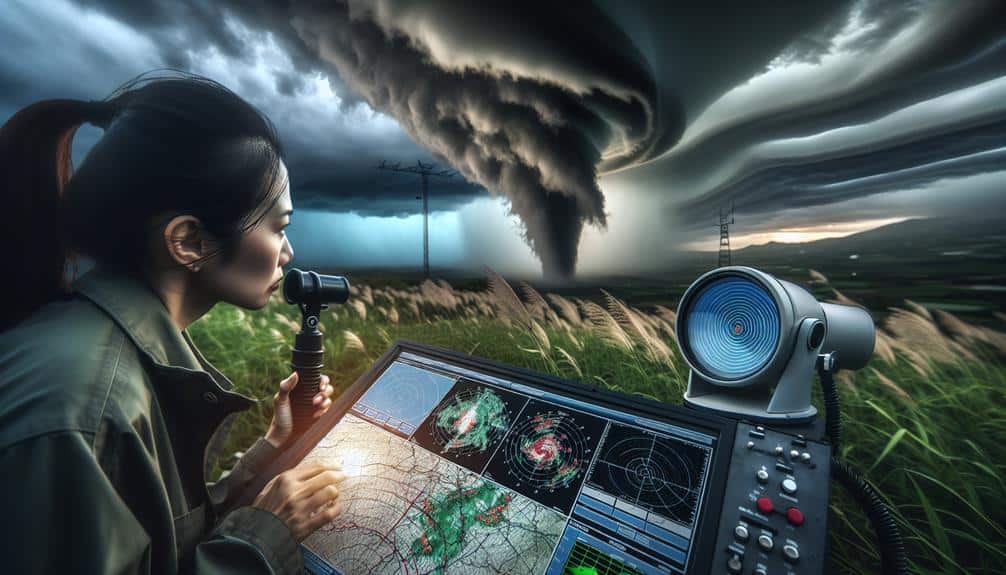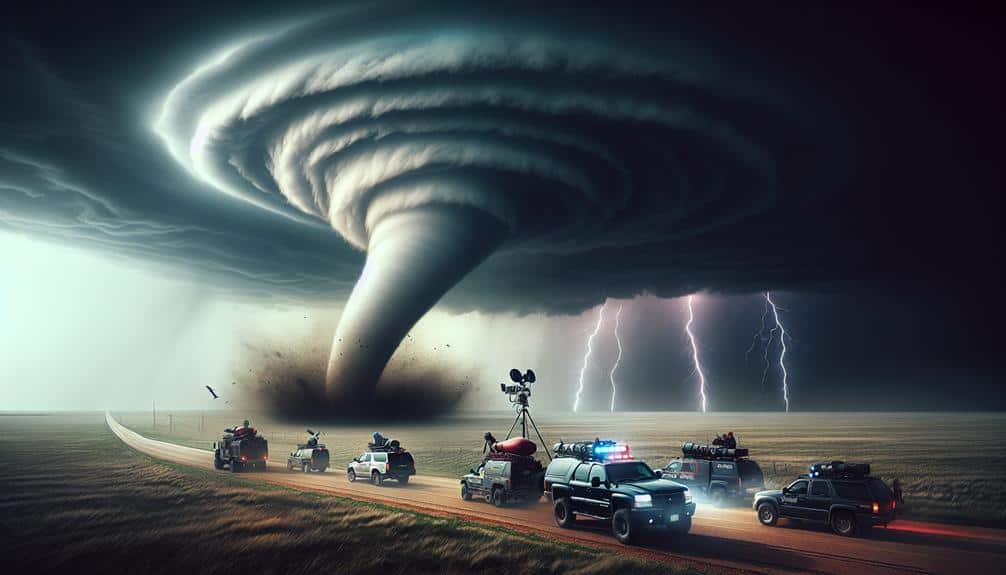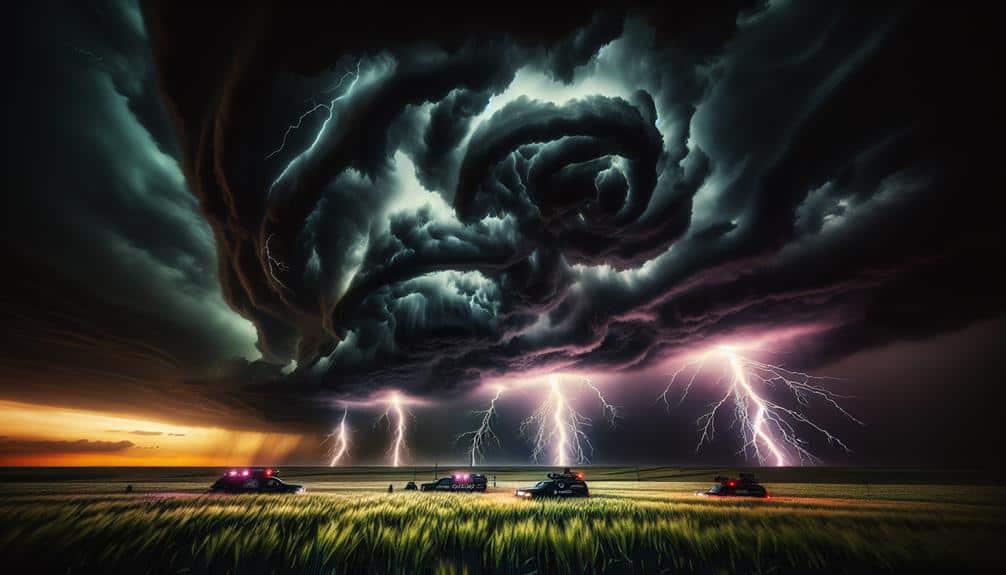For effective and safe storm chasing, we must prioritize ideal hydration and balanced nutrition to maintain energy and cognitive function. Cardiovascular fitness and strength training are essential for stamina and handling equipment. We should practice stress management techniques like mindfulness and simulation drills to stay calm under pressure. Wearing proper safety gear, including footwear with traction and helmets, is non-negotiable. Finally, understanding weather patterns and using forecasting tools enhances our ability to predict storm movements and stay safe. By covering these essentials, we're better prepared for the demanding challenges of storm chasing. Discover more detailed tips and strategies to enhance your safety and performance.
Key Points
- Stay hydrated by drinking at least 3 liters of water daily to maintain cognitive and physical performance.
- Consume balanced meals rich in complex carbohydrates, lean proteins, and healthy fats for sustained energy.
- Engage in cardiovascular and strength training exercises to enhance stamina and muscle power.
- Practice stress management techniques like controlled breathing and mindfulness to remain calm under pressure.
Hydration and Nutrition
When storm chasing, it's important that we maintain optimal hydration and nutrition to guarantee peak physical and mental performance in challenging conditions. We can't underestimate the necessity of precise meal planning and sufficient water intake. These elements are vital for sustaining our energy levels and cognitive function when moving through unpredictable weather.
Meal planning should involve balanced, nutrient-rich foods that can be easily consumed on the go. We need to prioritize complex carbohydrates, lean proteins, and healthy fats to provide long-lasting energy. Nuts, dried fruits, and protein bars are excellent options that require minimal preparation and offer substantial nutritional benefits. Preparing meals in advance ensures we don't rely on fast food or unhealthy snacks, which could compromise our performance.
Equally important is our water intake. Dehydration can impair our judgment and reaction times, both of which are essential when we're in the field. We should aim to drink at least 3 liters of water daily, adjusting for increased physical activity and heat exposure. Carrying a reusable water bottle with clear markings can help us track our consumption.
Physical Fitness
Maintaining physical fitness is vital for storm chasers to make sure we can withstand the physical demands and rapid movements required in high-stress environments. Our bodies need to be resilient and agile, which means incorporating thorough exercise routines into our daily lives.
Cardiovascular exercises like running or cycling enhance our stamina, guaranteeing we can keep pace with fast-moving storms. Strength training, including weightlifting and bodyweight exercises, builds the muscle power needed to handle equipment and navigate challenging terrains.
Equally important are our stretching techniques, which increase flexibility and reduce the risk of injuries. Dynamic stretches, such as leg swings and arm circles, are beneficial before heading out, as they prepare our muscles and joints for activity. Post-chase, static stretching helps us cool down and maintain muscle elasticity, preventing stiffness and soreness.
A well-rounded fitness regimen ensures we're always ready for the unexpected. By diversifying our exercise routines and incorporating vital stretching techniques, we enhance our capability to respond swiftly and effectively.
Physical fitness isn't just about strength or endurance; it's about preparation and adaptability, essential elements for those of us who thrive on the freedom of chasing nature's most formidable phenomena.
Mental Preparedness
While physical fitness equips our bodies for the rigors of storm chasing, honing our mental preparedness guarantees we remain calm, focused, and decisive under pressure. Storm chasing demands not only physical endurance but also the capacity to manage stress and maintain emotional stability in high-stakes situations.
To achieve the best mental preparedness, we should focus on three critical areas:
- Stress Management Practices: Techniques such as controlled breathing, mindfulness, and visualization can greatly reduce anxiety levels. These practices help us to remain clear-headed and make quick, accurate decisions during the chaos of a storm.
- Simulation Drills: Regularly engaging in scenario-based training allows us to rehearse our responses to various emergency situations. By simulating high-pressure environments, we condition our minds to react efficiently and effectively, minimizing hesitation and enhancing decision-making.
- Emotional Support Systems: Building a network of supportive peers and mentors is essential. Having someone to debrief with after a chase or to talk to about the emotional toll can provide crucial relief and foster resilience.
Safety Gear
Selecting the appropriate safety gear is pivotal for storm chasers, as it significantly enhances our capacity to navigate hazardous conditions and mitigate potential risks. Proper footwear is indispensable; we require boots that offer excellent traction, are waterproof, and have steel toes to shield against debris. These features not only safeguard us against immediate physical harm but also guarantee our mobility in various terrains, from muddy fields to rocky outcrops.
Protective eyewear is another crucial component. High-impact, shatterproof glasses shield our eyes from flying debris and intense wind, which can carry particles at high speeds. Some eyewear options even come with UV protection, which is essential when we're exposed to the sun for prolonged periods. This ensures our vision remains unimpaired, vital for making quick, informed decisions in volatile environments.
Moreover, a sturdy helmet is required to protect our heads from falling objects. A multi-layered, high-density helmet can absorb shocks and reduce the risk of head injuries.
With all these elements combined, our safety gear forms a thorough shield that allows us to pursue our passion without compromising our health and well-being. Let's gear up and chase storms safely.
Weather Awareness

Understanding the intricacies of weather patterns is crucial for us to anticipate and navigate the volatile conditions inherent in storm chasing. Mastery over weather tracking and forecasting techniques allows us to predict storm movements and potential hazards. Utilizing sophisticated tools like Doppler radar, satellite imagery, and computer models, we can dissect meteorological data to make informed decisions.
Effective weather awareness also means having solid emergency plans and communication strategies in place. These are essential to guarantee our team's safety and cohesion. Real-time updates and constant communication allow us to adapt quickly to changing conditions.
Our strategies should include:
- Real-Time Weather Alerts: Subscribing to reliable weather alert systems guarantees we receive timely updates about severe weather.
- Predefined Meeting Points: Establishing specific rendezvous points in case of unexpected separation helps maintain team integrity.
- Emergency Contact Protocols: Keeping a list of emergency contacts and having a clear protocol for when and how to use them.
Frequently Asked Questions
How Can Storm Chasers Manage Stress During Long Chases?
We can manage stress during long chases by prioritizing stress management and self-care. Developing mental resilience through effective coping strategies, such as mindfulness and regular breaks, guarantees we stay focused and maintain our freedom to chase storms.
What Are the Best Practices for Maintaining Vehicle Reliability in Harsh Weather?
Remember that time our engine failed in a tornado? To guarantee vehicle reliability in extreme weather, we conduct regular vehicle maintenance checks, focusing on tires and battery. Safety is paramount, so we take extra precautions with emergency supplies.
How Do Storm Chasers Communicate Effectively in Remote Areas?
We use satellite technology for reliable communication in remote areas. We also follow strict emergency protocols to guarantee safety. By combining these methods, we maintain constant contact and can respond quickly to any situation that arises.
What Are the Signs of Storm-Related Injuries That Require Immediate Attention?
Imagine a storm's fury, and we're in the thick of it. First aid becomes critical as we identify signs like severe bleeding, unconsciousness, or chest pain. Emergency response protocols kick in, ensuring swift, decisive actions for survival.
How Do Storm Chasers Handle Encounters With Wildlife?
When we handle wildlife encounters, we take strict safety precautions to avoid harm. In case of emergency response during animal encounters, we stay calm, assess the situation, and follow protocols to guarantee our freedom and safety.


